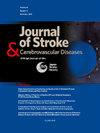Is there diurnal variation in neuroprotective and thrombolytic therapy effect upon acute cerebral ischemia outcome?
IF 2
4区 医学
Q3 NEUROSCIENCES
Journal of Stroke & Cerebrovascular Diseases
Pub Date : 2025-03-05
DOI:10.1016/j.jstrokecerebrovasdis.2025.108278
引用次数: 0
Abstract
Background
Preclinical studies have found marked diurnal/circadian variation in the effect of neuroprotective agents in acute ischemic stroke. However, the presence of diurnal variation in treatment outcomes after neuroprotective therapy has not been analyzed in human clinical trials and variation after thrombolytic therapy has been under-studied.
Methods
We analyzed patients with acute cerebral ischemia enrolled in the Field Administration of Stroke Therapy – Magnesium (FAST-MAG) randomized trial of magnesium sulfate started in the ambulance within two hours of stroke onset (last known well time). Patients with stroke onset times during daytime (07:00–22:59) and nighttime (23:00–06:59) were compared for variation in magnesium neuroprotective effect, thrombolysis effect, supportive care effect upon early neurologic course and three-month functional outcomes.
Results
Among 1235 acute cerebral ischemia patients, final diagnoses were acute ischemic stroke in 83.6 % and transient ischemic attack in 16.4 %. Time of onset was daytime in 1147 (92.8 %) and nighttime in 88 (7.2 %). Thrombolytic therapy was administered to 473 (38.3 %). Patients with night onset had longer onset to paramedic (median 32.5 vs 23 min); longer onset to Emergency Department arrival (median 70 vs 58 min); and higher prehospital systolic blood pressure (mean 162 vs 155 mm Hg). Among patients receiving thrombolysis, magnesium was associated with increased early neurological deterioration during night-time (50.0 % vs 23.1 %) but not day-time (21.1 % vs 22.4 %), p=0.03. However, no similar diurnal variation in magnesium or thrombolysis effects were noted for other early or three-month functional outcomes.
Conclusions
Among acute cerebral ischemia patients, efficacy, safety, neuroprotective agent, and thrombolytic response outcomes were largely unmodified by witnessed onset during active versus inactive phase clock times. These findings suggest biologic wake-sleep state rather than chronologic clock time is the driver of known circadian rhythmicity in stroke course.
神经保护和溶栓治疗对急性脑缺血结果的影响是否有昼夜变化?
背景:临床前研究发现,神经保护剂在急性缺血性卒中中的作用有明显的昼夜变化。然而,在人类临床试验中尚未分析神经保护治疗后治疗结果的日变化,并且对溶栓治疗后的变化研究不足。方法:我们分析了急性脑缺血患者,这些患者参加了脑卒中治疗-镁(FAST-MAG)随机试验,硫酸镁在中风发作后2小时内(最后已知时间)在救护车上开始。比较白天(07:00-22:59)和夜间(23:00-06:59)脑卒中患者镁的神经保护作用、溶栓作用、支持治疗对早期神经病程和3个月功能结局的影响。结果:1235例急性脑缺血患者中,最终诊断为急性缺血性脑卒中的占83.6%,短暂性脑缺血发作的占16.4%。发病时间为白天1147例(92.8%),夜间88例(7.2%)。溶栓治疗473例(38.3%)。夜间发病的患者到护理人员的发病时间较长(中位32.5 vs 23分钟);发病时间较长到到达急诊室(中位70分钟vs 58分钟);院前收缩压升高(平均162 vs 155 mm Hg)。在接受溶栓治疗的患者中,镁与夜间早期神经功能恶化增加相关(50.0% vs 23.1%),但与日间无关(21.1% vs 22.4%), p=0.03。然而,在其他早期或三个月的功能结局中,没有发现镁或溶栓效应的类似日变化。结论:在急性脑缺血患者中,疗效、安全性、神经保护剂和溶栓反应结果在很大程度上不受活跃与非活跃相时钟时间的影响。这些发现表明,生物觉醒-睡眠状态而不是生物钟时间是卒中过程中已知的昼夜节律性的驱动因素。
本文章由计算机程序翻译,如有差异,请以英文原文为准。
求助全文
约1分钟内获得全文
求助全文
来源期刊

Journal of Stroke & Cerebrovascular Diseases
Medicine-Surgery
CiteScore
5.00
自引率
4.00%
发文量
583
审稿时长
62 days
期刊介绍:
The Journal of Stroke & Cerebrovascular Diseases publishes original papers on basic and clinical science related to the fields of stroke and cerebrovascular diseases. The Journal also features review articles, controversies, methods and technical notes, selected case reports and other original articles of special nature. Its editorial mission is to focus on prevention and repair of cerebrovascular disease. Clinical papers emphasize medical and surgical aspects of stroke, clinical trials and design, epidemiology, stroke care delivery systems and outcomes, imaging sciences and rehabilitation of stroke. The Journal will be of special interest to specialists involved in caring for patients with cerebrovascular disease, including neurologists, neurosurgeons and cardiologists.
 求助内容:
求助内容: 应助结果提醒方式:
应助结果提醒方式:


